MICROSCOPE-ANTIQUES.COM © 2013-15.
BULLOCH/MEYROWITZ MICROSCOPE
c. 1891-1895
SIGNED: E.B.Meyrowitz MAKER, NEW YORK, BULLOCH PATENT 1879
SERIAL NUMBER: 201
MODEL: NEW BULLOCH BACTERIOLOGICAL
(formerly the BIOLOGICAL NUMBER 2 STAND
)
Please Click On Any Picture for a Larger Version
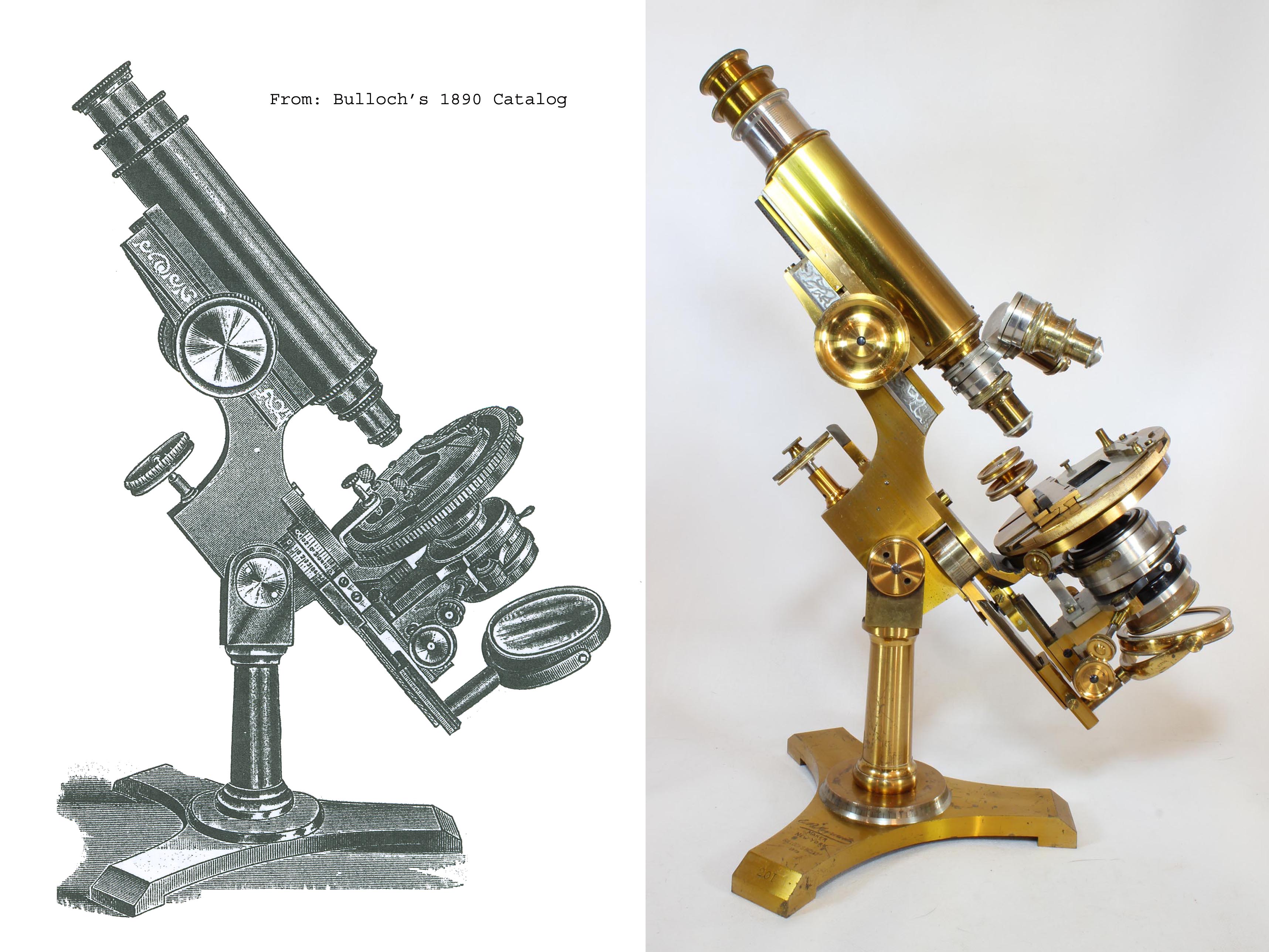
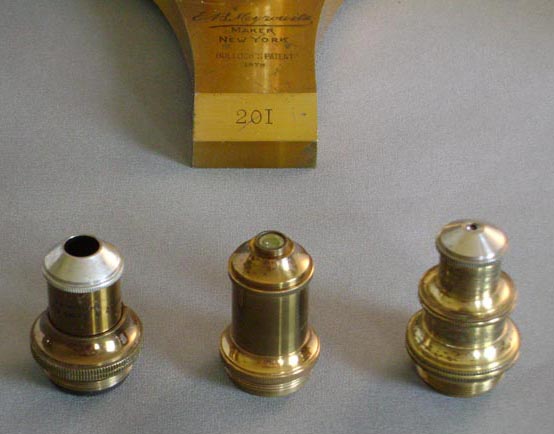

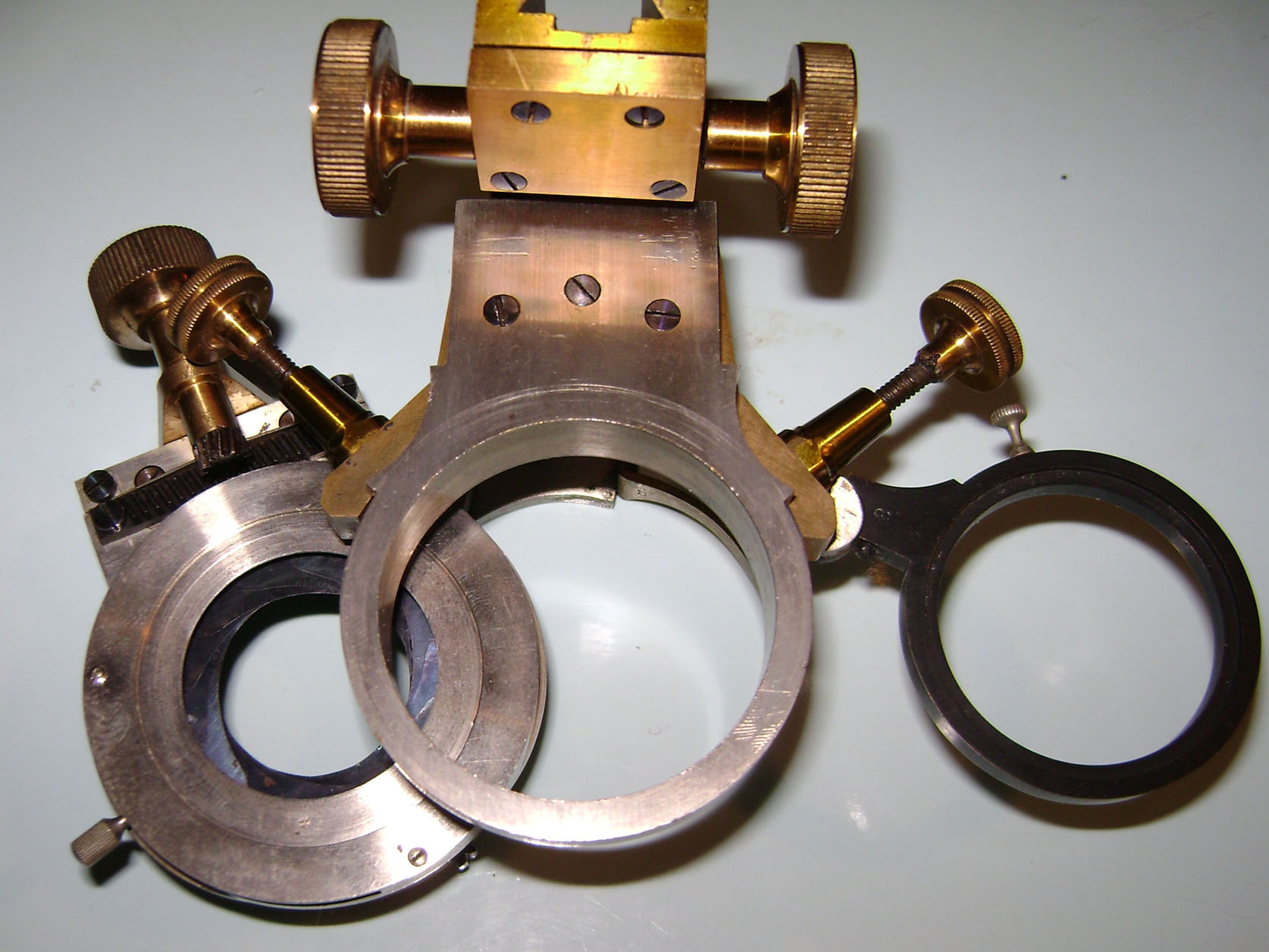
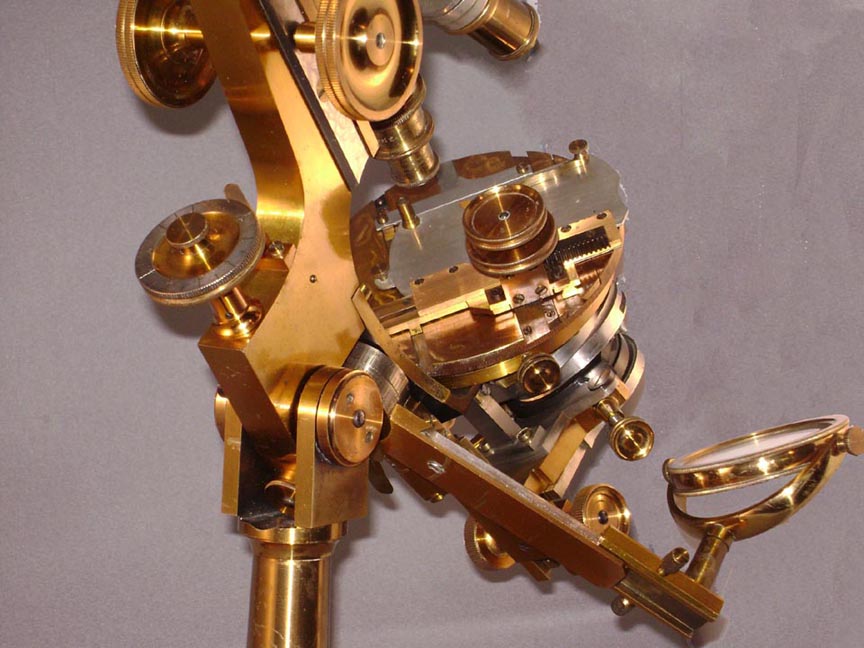
DESCRIPTION AND NOTES:
Signed in Script on the Foot: E.B. Meyrowitz Maker New York.
In Addition, Stamped below the Signature:
Bulloch Patent 1879
. Numbered 201. The mechanical stage is controlled through concentric knobs projecting vertically.
There is a decorative damascened finish to the surface of the stage in brass, and also to the silver-colored metal part
of the limb. There is a matching triple opening vertical illuminator in brass and silver-color metal and a matching triple nose piece. Three objectives, one unsigned, two by Bausch & Lomb: Bausch & Lomb Optical Co
Rochester N.Y. 1/6 0.85 n.a. 180.0 mm tube length
and Bausch & Lomb Optical Co Rochester N.Y. 3" 0.08 n.a.
180 mm tube length.
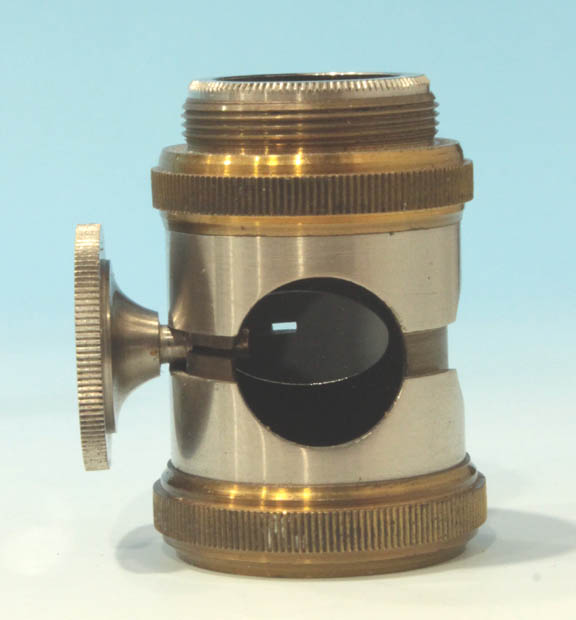 An additional accessory that came with this microscope is a Bulloch-Meyrowitz Vertical Illuminator (left).
An additional accessory that came with this microscope is a Bulloch-Meyrowitz Vertical Illuminator (left).
There is a very complex substage with iris. The substage has separate calibrated straight swinging arms for the mirror and the condenser assembly for which Bulloch held a 1879 patent. The condenser assembly can be swung out of the optical axis either in parts or in whole.
Silvered scales are present on the foot at the base of the pillar; on the fine focus, on the stage, and on
each of the two substage arms. The fine focus wheel is calibrated in 1/1000 inch intervals and has groove
in which a cord could have been placed for remote control of focus during photography, which in those days
required large apparatus. Although the calibrated revolving base could be used to measure numerical aperture,
its purpose as described by Bulloch was as a convenience for photography. Originally supplied with revolving glass stage with a gliding slide holder, the mechanical stage was sold for $20 or for $15 in place of the glass stage as was quoted for the professional No 2 stand. The Biological No 2 is a more elaborate microscope than the biological No 1, and identical to the professional No 2 except for a shorter tube length (5-6 inches) as shown by catalog photographs, descriptions, and actual measurements. The chromed calibrated draw tube
extends the tube length to the standard 9 inches.
This stand with Abbe condenser, polarizer, 2 selenites, two
eyepieces and two objectives with a mechanical stage would have sold for $200 in the 1880's.
Although of a lower serial number than some Bulloch stands (which number up to at least 675), this stand was produced, or at least modified after 1891 after Bulloch had died. Although invented by Swift in England in 1881, diagonal rack and pinion was not used by Bulloch himself, or most other American microscope makers in the 1880's. Meyrowitz pointed out in their catalog, that this was one of the improvements they had made once Bulloch had died and they took over his business. The use of a Kohler substage condenser, is also not seen on American stands until the 1890's, and the knob used for the Kohler condenser is clearly not of the type made by Bulloch and had to be made later; this knob is found on other Meyrowitz-signed Bulloch microscopes.
HISTORY OF THE BULLOCH MICROSCOPES
Walter H Bulloch was born in Scotland and emigrated with his parents to New York as a teenager.
He was soon apprenticed to Benjamin Pike and Sons where he learned the art of fine machining (and apparently microscope design).
He soon joined in partnership with the famous objective maker William Wales, who made objectives, selling his stands with Wales objectives,
but eventually moved to Chicago in 1866. Despite the apparent work with Wales, stands by Bulloch from that time, before his move to Chicago,
have not yet been identified. Although he initially prosperred in Chicago, the Great Chicago Fire of 1871 destroyed his premises and he never
completely recovered from this loss. To the best of my knowledge, microscopes dating from this early period in Chicago have also not been
firmly identified. Following the 1871 fire he left Chicago and went to Boston to work with the famous Robert B Tolles, inventor of the oil-immersion
objective. He was back in business in Chicago by 1872, and stands dating from about 1875 have been identified. As is evidenced by a signature
on stand number 77, his agent in Chicago in that era was T. F. Nelson. T.F. Nelson apparently declared Bankruptcy in 1879 according to the
Chicago Daily Law Bulletin, volume 25.
A 1879 patent is for features of his design used on the Professional,
Biological, and 'A1' Congress stands. His design for the Congress stand was published in the Journal of the Royal Microscopical Society in 1880
and the improved version, starting about 1882 as is pictured and described on this website here.
In 1889 he again left Chicago for a brief time
working for the U.S. Geodetic Survey as part of the Bureau of weights and measures but he again returned to Chicago after only six months with the
Survey group. In 1890 he opened business again in Chicago, but had longstanding bad health and died in November of 1891.
For a few months after his death, a M. Von Mehren took over his business but his entire business was shortly then taken over by the 'opticians' E.B. Meyrowitz of New York City, (who were already his agents long before his death), and several surviving instruments have the Meyerowitz signature on the foot (for a listing of just the Meyrowitz-signed instruments see the Meyrowitz Serial Number Page. Meyrowitz was then the leading manufacturer of spectacles and also of equipment to examine the eyes, ears and throat. This microscope reflects changes made in Bulloch instruments by Meyrowitz after Bulloch died, including diagonal rack with spiral pinion focusing and a Kohler type of substage condenser. Meyrowitz described their changes in the introduction section of the Meyrowitz 1894 catalog. Neither of these features were ever used by Bulloch himself. According to the Meyrowitz 1894 catalog entry for this microscope, they renamed this modified version of the Biological No. 2 the 'New Bulloch Bacteriological' model. Meyrowitz continued to sell microscopes of other makers even after they stopped selling Bulloch microscopes. At various times they sold and were agents for Reichert(1894), Zentmayer, and Zeiss(1908).
As noted above, there is no record known to the author of Bulloch ever making his own objectives. However Bulloch made impressive stands,
especially his Congress stand, the Professional, Lithological, and the Biological Number 2. Bulloch made relatively few stands compared to
many other well-known makers. This is in part due to the limited time he was in business, and the fact that he was
a perfectionist. Anyone who has had the priviledge of handling Bulloch instruments cannot help but admire his quality of workmanship
and his very sound designs.
The engraving shown above depicts the Biological No. 2 with a sliding glass stage instead of the upgraded Bulloch mechanical stage on the instrument pictured here. This stage was also offered by Meyrowitz for an extra $25.
For a tabular listing of Bulloch's locations and activities see the Bulloch Chronology Page. Pages devoted to all the different Bulloch microscope models illustrated with both engravings and actual examples are on this site-see the articles link above for this and other Bulloch-related articles.





